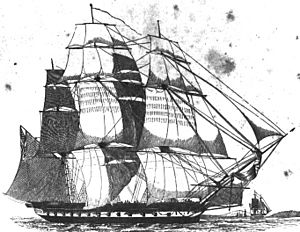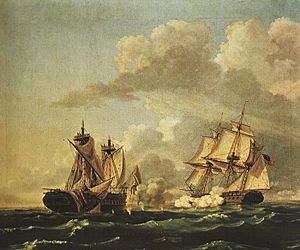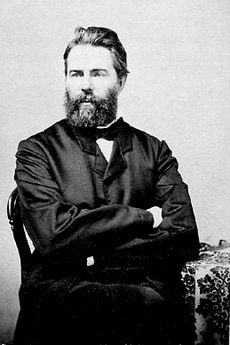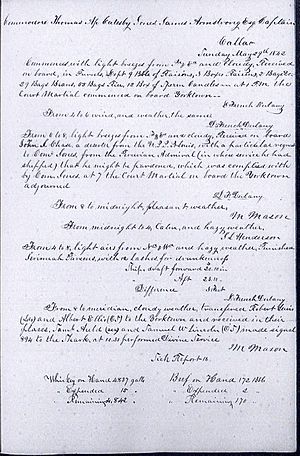USS United States (1797) facts for kids
class="infobox " style="float: right; clear: right; width: 315px; border-spacing: 2px; text-align: left; font-size: 90%;"
| colspan="2" style="text-align: center; font-size: 90%; line-height: 1.5em;" | 
|} The USS United States was a large, wooden warship with three masts. It was the very first of six special frigates built for the United States Navy. These ships were ordered in 1794 to protect American merchant ships.
The United States was designed by Joshua Humphreys. It was built in Philadelphia, Pennsylvania, and launched on May 10, 1797. Soon after, it started protecting American trade ships during the Quasi-War with France.
Later, in 1861, the United States was in Norfolk, Virginia. It was taken over by the Virginia Navy and then became part of the Confederate Navy. It was renamed CSS United States. However, Confederate forces later sank it to block the harbor. The U.S. Navy raised the ship after taking back Norfolk. But the old ship was too damaged to be used again. It was taken apart in December 1865.
Contents
| History | |
|---|---|
| Name | USS United States |
| Namesake | United States |
| Ordered | 27 March 1794 |
| Builder | Joshua Humphreys |
| Cost | $299,336 |
| Launched | 10 May 1797 |
| Nickname(s) | "Old Wagon" |
| Fate | Abandoned 20 April 1861 |
| Name | CSS United States |
| Acquired | 20 April 1861 |
| Fate | Abandoned May 1862 |
| Name | USS United States |
| Acquired | May 1862 |
| Fate | Broken up December 1865 |
| General characteristics | |
| Class and type | First class frigate |
| Tons burthen | 1576 tons |
| Length |
|
| Beam | 43 ft 6 in (13.26 m) |
| Draft | 23 ft 6 in (7.16 m) aft |
| Decks | Orlop, Berth, Gun, Spar |
| Propulsion | Sail |
| Speed | 11 kn (20 km/h; 13 mph) |
| Complement | 400 to 600 officers, enlisted personnel and 50 Marines |
| Armament | 32 × long 24-pounders (11 kg), 24 × 42-pounder (19 kg) carronades (War of 1812) |
Building a Powerful Warship
The United States was a new country in the 1790s. American merchant ships faced attacks from pirates in the Mediterranean Sea. These pirates were called Barbary pirates. To fight them, Congress decided to build six frigates in 1794.
A Special Design for Speed and Strength
Joshua Humphreys designed these frigates to be very strong and fast. They were built with thick wood and a special frame. This made their hulls much stronger than other frigates. Humphreys knew the U.S. Navy couldn't be as big as European navies. So, he designed ships that could beat other frigates in a fight. But they also had to be fast enough to escape bigger warships.
The United States was the first of these ships to be built. Its keel was laid down in 1795 in Philadelphia. John Barry became its first captain. Many people, including President George Washington, visited the shipyard to see the ship being built.
Stopping and Starting Construction
Work on the United States stopped in March 1796. This happened because the U.S. made a peace treaty with Algiers. But President Washington asked Congress to let them finish the three ships that were almost done. The United States, Constellation, and Constitution were chosen.
On May 10, 1797, the United States was launched. It was the first American warship launched under the new law. It was prepared for duty in 1798. On July 3, it was ordered to sea. This was because relations with France were getting worse, leading to the Quasi-War.
Ship's Weapons
The United States was designed to have 44 guns. But it usually carried more than 50. It started with 32 large 24-pounder cannons and 22 shorter 42-pounder carronades. It also had one 18-pounder long gun.
Ships back then didn't have a fixed set of guns. Captains could change the weapons based on their mission. They considered the cargo, crew size, and planned routes. So, the ship's guns often changed over time.
The Quasi-War with France
The United States sailed to the West Indies in July 1798. It was part of a squadron led by Captain Barry. Their job was to protect American ships from French privateers.
Early Encounters and Captures
In the first two months, the United States captured two French privateer ships. These were the Sans Pareil and Jalouse. They were taken to New Castle, Delaware.
In October, the United States was hit by a bad storm. It damaged the ship's front mast and ropes. After repairs, it returned to the West Indies. Captain Barry took command of the American squadron there.
On February 3, 1799, the United States chased a French ship called L'Amour de la Patrie. After five hours, the United States fired. One shot went right through the French ship, sinking it quickly. Barry rescued the survivors and took them prisoner.
Barry tried to exchange prisoners with the French in Guadeloupe. But the French governor said he had no American prisoners. Barry released his prisoners anyway.
More Captures and Return Home
On March 26, the United States captured another French privateer, La Tartueffe. It also took back an American ship called Vermont. Another French ship, Le Bonaparte, was captured in 1799.
In April, Captain Barry handed over command of the squadron. The United States sailed home, arriving on May 9. It underwent repairs and got new crew members. It then patrolled the southern Atlantic coast.
In October, the United States was ordered to take two American envoys, Oliver Ellsworth and William Davie, to France. They were going to negotiate a peace treaty. The ship returned in April 1800.
The peace treaty with France was signed in February 1801. The United States returned home in April. Congress decided to keep thirteen frigates. Seven of them, including the United States, were put into a reserve fleet. The United States was taken out of service in Washington D.C.
The War of 1812
The United States stayed out of service until 1809. Then, it was prepared for active duty again. On June 10, 1810, Stephen Decatur became its new commander.
A Friendly Wager
While in Norfolk, Captain John S. Carden of the British ship HMS Macedonian made a bet with Captain Decatur. He bet a beaver hat that his ship would capture the United States if they ever met in battle.
The United States declared war on Britain on June 18, 1812. Three days later, Decatur and the United States sailed from New York City. They were part of a squadron led by Commodore John Rodgers. They went on a seventy-day cruise in the North Atlantic.
The squadron chased a fleet of British merchant ships. They sailed close to the English Channel but never found the convoy. On their way back to Boston, they captured seven merchant ships.
After some repairs, the United States sailed again on October 8. Three days later, on October 25, lookouts spotted a ship. It was the HMS Macedonian.
United States vs. Macedonian
Both ships got ready for battle. Captain Carden of Macedonian decided to sail alongside the United States. Decatur planned to fight from a distance. His 24-pounder guns were more powerful than the British ship's 18-pounders.
The battle began at 9:20 AM. The United States fired first. Its second shot hit Macedonian's mast, giving the American ship an advantage. The United States then moved into a good position and fired many shots at Macedonian.
By noon, Macedonian was badly damaged and had lost its masts. It was forced to surrender. Macedonian had 104 casualties, while the United States had only 12. The American ship was barely damaged.
The two ships stayed together for over two weeks while Macedonian was repaired enough to sail. The United States and its captured prize arrived in New York Harbor on December 4. Everyone celebrated the victory. Captain Decatur and his crew were praised by Congress and President James Madison.
After the Battle
The United States Navy bought the Macedonian. It was repaired and put into service. After repairs, the United States sailed again on May 24, 1813. It was joined by the new USS Macedonian and the sloop Hornet.
During this trip, two women, Mary Marshall and Mary Allen, served aboard the United States. They were the wives of crew members. They worked as nurses to care for the wounded. They are thought to be the first women to serve on a U.S. warship.
On June 1, the three ships were forced into New London, Connecticut, by a strong British squadron. The United States and Macedonian were stuck there until the war ended. Their crews and weapons were sent to other ships.
The Second Barbary War
After the War of 1812, Algiers started attacking American merchant ships again. On March 2, 1815, Congress declared war on Algiers.
The United States was assigned to a squadron under Commodore William Bainbridge. But it needed repairs after being stuck in port. So, it wasn't ready when Bainbridge left.
The United States finally sailed for the Mediterranean two months later. It was commanded by Captain John Shaw. When it arrived, Captain Shaw learned that Commodore Decatur had already made a peace treaty with Algiers. The United States stayed in the Mediterranean until 1819. It then sailed home and was taken out of service on June 9, 1819. It was stored at Norfolk.
Pacific Squadron Duty
The United States returned to duty in November 1823. It was commanded by Commodore Isaac Hull. On January 5, 1824, it sailed to the Pacific Ocean. Its mission was to protect American trade.
Exploring and Protecting Trade
The United States arrived in Valparaiso, Chile, on March 7. Commodore Hull found that Chile was now independent. His orders were to stay neutral in the war between Chile and Peru. He had to protect American businesses.
The United States stayed near Peru. Its time there was mostly peaceful. In 1825, Lieutenant John Percival was sent to find mutineers from a whaling ship called Globe. Percival found only two mutineers. But he also discovered an uncharted island, which he named "Hull's Island." Today, it's known as Îles Maria.
Commodore Hull's duty ended. The United States left Peru on December 16, 1826. It arrived in New York on April 24, 1827.
The ship underwent major repairs from 1828 to 1830. It then stayed in reserve until 1832. From 1832 to 1834, it served in the Mediterranean. It returned to the Mediterranean again from 1836 to 1838. From 1839 to 1840, it was part of the Home Squadron.
The Capture of Monterey
The United States was repaired in 1841. It became the flagship for Commodore Thomas ap Catesby Jones in the Pacific Squadron. On September 6, 1842, while in Peru, Commodore Jones saw a British ship. He suspected the British wanted to take California.
So, the United States and another ship, Cyane, sailed north. They captured Monterey, California, on October 16. But the next day, Jones realized that the U.S. and Mexico were still at peace. He tried to fix his mistake.
While waiting for new orders, Jones heard that a British captain had claimed the Hawaiian Islands. He sailed there, arriving on July 22. Another British admiral arrived a few days later and gave control back to the Kingdom of Hawaii.
Herman Melville's Journey
Herman Melville, who later wrote the famous book Moby-Dick, joined the United States crew. He signed up in Honolulu, Hawaii, on August 18, 1843. His novel White-Jacket is based on his experiences on this ship. He wrote about the crew and naval life.
From Hawaii, the United States (which Melville called USS Neversink in his book) visited the Marquesas Islands, Chile, and Peru.
The United States stayed in Peru for 10 weeks. The crew was not allowed to go ashore. The only fun they had was a race. The United States raced against the Constellation and a British ship, HMS Vindictive. The United States easily won.
The ship sailed home in mid-1844. It arrived in Boston on October 2 and was taken out of service on October 14.
It was put back into service on May 18, 1846. It was sent to Africa to stop the illegal slave trade. In 1847, it joined the Mediterranean Squadron. It served in Europe until late 1848. It returned to Norfolk on February 17, 1849, and was taken out of service again.
The Civil War and Final Days
The United States stayed in Norfolk until April 20, 1861. That's when Confederate troops captured the navy yard. Union forces tried to burn the ships they left behind, but they didn't burn the United States because it was old.
The Confederates needed ships. They pumped water out of the United States and put it into service as the CSS United States on April 29. It was used as a receiving ship with 19 guns for harbor defense.
In May 1862, the Confederates left the navy yard. They sank the United States in the Elizabeth River, Virginia, to block Union ships. After Union troops took back Norfolk, they raised the United States. But the ship was too old and damaged to be used again. It stayed at the Norfolk Navy Yard until December 1865. Then, it was finally taken apart.
Images for kids







